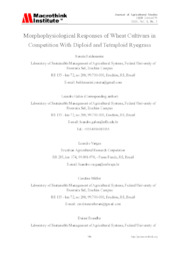Morphophysiological responses of wheat cultivars in competition with diploid and tetraploid ryegrass.
Morphophysiological responses of wheat cultivars in competition with diploid and tetraploid ryegrass.
Author(s): VARGAS, L.
Summary: Wheat crop growth and development can be affected by weed infestation, especially ryegrass. Thus, the objective of this study was to evaluate the competitive ability of wheat cultivars wit h the diploid and tetraploid ryegrass biotypes. Greenhouse experiments were conducted in a completely randomized design with four replications. BRS Parrudo and TBIO Sinuelo wheat cultivars and the competitors ryegrass diploid and tetraploid were used. The population of each species was defined and then the replacement series experiments were carried out, containing the following proportions of wheat and ryegrass plants: 100:0, 75:25, 50:50, 25:75; and 0:100%, equivalent to 32:0; 24:8; 16:16; 8:24; and 0:32 plants per pot. Fifty days after species emergence, physiological traits, such as photosynthetic activity ( A ), stomatal conductance ( g S ), transpiration rate E ), internal concentration of mesophyll CO 2 (C i ), water use efficiency (WUE), and carboxylation ef ficiency (CE), were evaluated, along with the morphological traits of leaf area (LA), stem diameter (SD), number of tillers (NT), and shoot dry mass (DM). Competitiveness analysis was performed by means of diagrams applied to substitutive experiments using relative competitiveness indices. The ryegrass, both diploid and tetraploid, had a negative effect on the variables related to A , WUE and also those associated with plant growth. The ryegrass negatively changed the LA, DM, SD, and NT of the cultivars BRS Parrudo and TBIO Sinuelo, which demonstrates competition between the cultivars of wheat and the weed ryegrass with mutual damage to the species involved in th recommended for wheat cultivation.
Publication year: 2020
Types of publication: Journal article
Unit: Embrapa Wheat
Observation
Some of Embrapa's publications are published as ePub files. To read them, use or download one of the following free software options to your computer or mobile device. Android: Google Play Books; IOS: iBooks; Windows and Linux: Calibre.
Access other publications
Access the Agricultural Research Database (BDPA) to consult Embrapa's full library collection and records.
Visit Embrapa Bookstore to purchase books and other publications sold by Embrapa.

